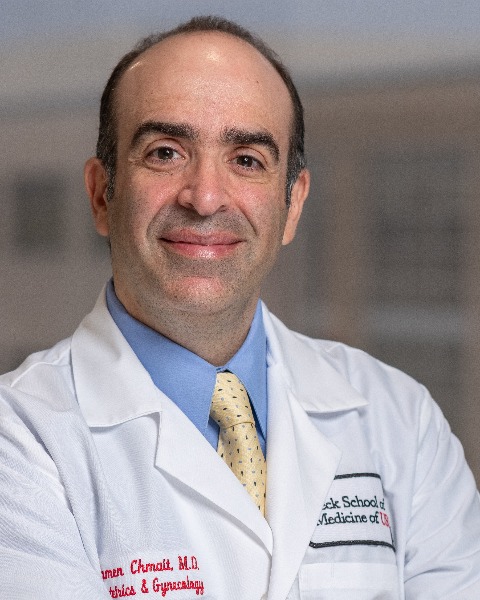Poster Session 4
(1163) Rate of tethered spinal cord release after fetoscopic repair of open spina bifida

Ramen H. Chmait, MD (he/him/his)
Director, Los Angeles Fetal Surgery; Professor, Department of Obstetrics and Gynecology
Keck School of Medicine, University of Southern California
Los Angeles, California, United States- JC
Jason K. Chu, MD
Assistant Professor of Neurological Surgery
Riley Hospital for Children, Indianapolis
Indianapolis, Indiana, United States - AV
Alexander L. Van Speybroeck, MD
Associate Professor of Clinical Pediatrics
Children's Hospital Los Angeles
Los Angeles, California, United States - HN
HaiThuy N. Nguyen, MD
Children's Hospital Los Angeles
Los Angeles, California, United States - AL
Arlyn Llanes, MHA, RN
Keck School of Medicine, University of Southern California
Los Angeles, California, United States - GH
Grace Hamadeh, BS
Keck School of Medicine, University of Southern California
Los Angeles, California, United States - AM
Adam E. Masri
Keck School of Medicine, University of Southern California
Los Angeles, California, United States - LK
Lisa M. Korst, MD, PhD
Childbirth Research Associates
North Hollywood, California, United States - EK
Eftichia V. Kontopoulos, MD
The Fetal Institute, USFETUS Research Consortium
Miami, Florida, United States .jpg)
Ruben A. Quintero, MD (he/him/his)
The Fetal Institute, USFETUS Research Consortium
Miami, Florida, United States- DL
Denise A. Lapa, MD, PhD
Hospital Israelita Albert Einstein, Hospital Infantil Sabara
Sao Paulo, Sao Paulo, Brazil
Submitting Author and Presenting Author(s)
Coauthor(s)
Study Design:
This was a prospective study of patients who underwent percutaneous or percutaneous mini-laparotomy fetoscopic OSB repair between 24 and 28 gestational weeks and who were followed for 2.5 to 5 years of life. The postnatal evaluation and treatment were at the discretion of the referring team and based on clinical findings and symptoms.
Of patients who underwent fetoscopic OSB repair and were between 2.5 to 5 years of age, 5.7% underwent a surgical TSC release procedure. As TSC symptomology may not arise until the later childhood or adolescent period, further long term follow up is necessary. Understanding the risk factors for development of symptomatic TSC will be important to optimize the prenatal surgical approach.
Results: Of 105 consecutive patients who received the fetoscopic OSB repair and achieved 30 months of age, 6 (5.7%) underwent a surgical TSC release procedure. Table 1 shows specific details of these 6 cases. Four of these 6 patients developed symptomatic hydrocephalus and were treated with a shunt or endoscopic third ventriculostomy, two at the same time of the TSC release. Because of the small number of affected patients, risk factors for receiving a detethering procedure could not be assessed.
Conclusion:

